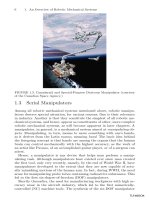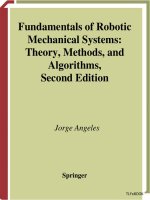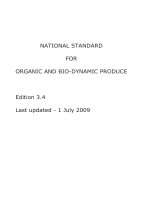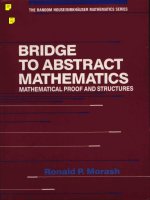CRC standard mathematical tables and formulae, thirtieth edition
Bạn đang xem bản rút gọn của tài liệu. Xem và tải ngay bản đầy đủ của tài liệu tại đây (11.88 MB, 775 trang )
www.pdfgrip.com
This book contains information obtained from authentic and highly regarded sources. Reprinted
material is quoted with permission, and sources are indicated. A wide variety of references are listed.
Reasonable efforts have been made to publish reliable data and information, but the author and the publisher
cannot assume responsibility for the validity of all materials or for the consequences of their use.
Neither this book nor any part may be reproduced or transmitted in any form or by any means,
electronic or mechanical, including photocopying, microfilming, and recording, or by any information
storage or retrieval system, without prior permission in writing from the publisher.
All rights reserved. Authorization to photocopy items for internal or personal use, or the personal or
internal use of specific clients, may be granted by CRC Press, Inc., provided that $.50 per page photocopied
is paid directly to Copyright Clearance Center, 27 Congress Street, Salem, MA 01970 USA. The fee code
for users of the Transactional Reporting Service is ISBN 0-8493-2479-3/96 $0.0 + $.50. The fee is subject
to change without notice. For organizations that have been granted a photocopy license by CCC, a separate
system of payment has been arranged.
CRC Press, Inc.’s consent does not extend to copying for general distribution, for promotion, for
creating new works, or for resale. Specific permission must be obtained in writing from CRC Press for
such copying.
Direct all inquiries to CRC Press, Inc., 2000 Corporate Blvd., N.W., Boca Raton, Florida, 33431.
c 1996 by CRC Press, Inc.
No claim to original U.S. Government works
International Standard Book Number 0-8493-2479-3
Library of Congress Card Number 30-4052
Printed in the United States of America 1 2 3 4 5 6 7 8 9 0
Printed on acid-free paper
©1996 CRC Press LLC
www.pdfgrip.com
Editor-in-Chief
Daniel Zwillinger
Rensselaer Polytechnic Institute
Troy, New York
Associate Editors
Steven G. Krantz
Washington University
St. Louis, Missouri
©1996 CRC Press LLC
Kenneth H. Rosen
AT&T Bell Laboratories
Holmdel, New Jersey
www.pdfgrip.com
Editorial Advisory Board
George E. Andrews
Pennsylvania State University
University Park, Pennsylvania
Ben Fusaro
Salisbury State University
Salisbury, Maryland
William H. Beyer
The University of Akron
Akron, Ohio
Alan F. Karr
National Institute Statistical Sciences
Research Triangle Park, North Carolina
Robert Borrelli
Harvey Mudd College
Claremont, California
Steve Landsburg
University of Rochester
Rochester, New York
Michael F. Bridgland
Center for Computing Sciences
Bowie, Maryland
Al Marden
University of Minnesota
Minneapolis, Minnesota
Courtney Coleman
Harvey Mudd College
Claremont, California
J. Douglas Faires
Youngstown State University
Youngstown, Ohio
Cleve Moler
The MathWorks
Natick, Massachusetts
William H. Press
Harvard University
Cambridge, Massachusetts
Gerald B. Folland
University of Washington
Seattle, Washington
©1996 CRC Press LLC
www.pdfgrip.com
Preface
It has long been the established policy of CRC Press to publish, in handbook form,
the most up-to-date, authoritative, logically arranged, and readily usable reference
material available. Prior to the preparation of this 30th Edition of the CRC Standard
Mathematical Tables and Formulae, the content of such a book was reconsidered.
Previous editions were carefully reviewed, and input obtained from practitioners in
the many branches of mathematics, engineering, and the physical sciences. The content selected for this Handbook provides the basic mathematical reference materials
required for each of these disciplines.
While much material was retained, several topics were completely reworked, and
many new topics were added. New and completely revised topics include: partial
differential equations, scientific computing, integral equations, group theory, and
graph theory. For each topic, old and new, the contents have been completely rewritten
and retypeset. A more comprehensive index has been added.
The same successful format which has characterized earlier editions of the Handbook is retained, while its presentation is updated and more consistent from page to
page. Material is presented in a multi-sectional format, with each section containing
a valuable collection of fundamental reference material—tabular and expository.
In line with the established policy of CRC Press, the Handbook will be kept as
current and timely as is possible. Revisions and anticipated uses of newer materials
and tables will be introduced as the need arises. Suggestions for the inclusion of
new material in subsequent editions and comments concerning the accuracy of stated
information are welcomed.
No book is created in a vacuum, and this one is no exception. Not only did we
start with an excellent previous edition, but our editorial staff was superb, and the
contributors did an amazingly good job. I wholeheartedly thank them all. There were
also many proofreaders, too many to name individually; again, thank you for your
efforts.
Lastly, this book would not have been possible without the support of my loving
wife, Janet Taylor.
Daniel Zwillinger
©1996 CRC Press LLC
www.pdfgrip.com
Contributors
Karen Bolinger
Clarion University
Clarion, Pennsylvania
Ray McLenaghan
University of Waterloo
Waterloo, Ontario
Patrick J. Driscoll
U.S. Military Academy
West Point, New York
John Michaels
SUNY Brockport
Brockport, New York
M. Lawrence Glasser
Clarkson University
Potsdam, New York
William C. Rinaman
LeMoyne College
Syracuse, New York
Jeff Goldberg
University of Arizona
Tucson, Arizona
Catherine Roberts
Northern Arizona University
Flagstaff, Arizona
Rob Gross
Boston College
Chestnut Hill, Massachusetts
John S. Robertson
Georgia College
Milledgeville, Georgia
Melvin Hausner
Courant Institute (NYU)
New York, New York
Joseph J. Rushanan
MITRE Corporation
Burlington, Massachusetts
Christopher Heil
Georgia Tech
Atlanta, Georgia
Neil J. A. Sloane
AT&T Bell Labs
Murray Hill, New Jersey
Paul Jameson
BBN
Cambridge, Massachusetts
Mike Sousa
MITRE Corporation
Burlington, Massachusetts
Victor J. Katz
MAA
Washington, DC
Gary L. Stanek
Youngstown State University
Youngstown, Ohio
Silvio Levy
Geometry Center
University of Minnesota
Minneapolis, Minnesota
Michael T. Strauss
Zwillinger & Associates
Newton, Massachusetts
Michael Mascagni
Supercomputing Research Center
Bowie, Maryland
Nico M. Temme
CWI
Amsterdam, The Netherlands
©1996 CRC Press LLC
www.pdfgrip.com
George K. Tzanetopoulos
University of Rhode Island
Kingston, Rhode Island
Brad Wilson
SUNY Brockport
Brockport, New York
Ahmed I. Zayed
University of Central Florida
Orlando, Florida
©1996 CRC Press LLC
www.pdfgrip.com
Table of Contents
Chapter 1
Analysis
John S. Robertson, Karen Bolinger, M. Lawrence Glasser, Neil J.A. Sloane,
and Rob Gross
Chapter 2
Algebra
Brad Wilson, John Michaels, Patrick J. Driscoll, and Rob Gross
Chapter 3
Discrete Mathematics
George K. Tzanetopoulos, Jeff Goldberg, Joseph J. Rushanan, and Mel Hausner
Chapter 4
Geometry
Ray McLenaghan and Silvio Levy
Chapter 5
Continuous Mathematics
Catherine Roberts and Ray McLenaghan
Chapter 6
Special Functions
Ahmed I. Zayed, Nicco M. Temme, and Paul Jameson
Chapter 7
Probability and Statistics
William C. Rinaman, Christopher Heil, Michael T. Strauss, Michael Mascagni,
and Mike Sousa
Chapter 8
Scientific Computing
Gary Stanek
Chapter 9
Financial Analysis
Daniel Zwillinger
Chapter 10
Miscellaneous
Michael T. Strauss, Rob Gross, and Victor J. Katz
List of Notations
©1996 CRC Press LLC
www.pdfgrip.com
Chapter
1
Analysis
1.1
CONSTANTS
1.1.1
1.1.2
1.1.3
1.1.4
1.1.5
1.1.6
1.1.7
1.1.8
1.2
SPECIAL NUMBERS
1.2.1
1.2.2
1.2.3
1.2.4
1.2.5
1.2.6
1.2.7
1.2.8
1.2.9
1.2.10
1.2.11
1.2.12
1.2.13
1.2.14
1.2.15
1.3
Types of numbers
Representation of numbers
Decimal multiples and prefixes
Roman numerals
Decimal equivalents of common fractions
Hexadecimal addition and subtraction table
Hexadecimal multiplication table
Hexadecimal–decimal fraction conversion table
Positive powers of 2
Negative powers of 2
Powers of 16 in decimal scale
Powers of 10 in hexadecimal scale
Special constants
Factorials
Important numbers in different bases
Bernoulli polynomials and numbers
Euler polynomials and numbers
Fibonacci numbers
Powers of integers
Sums of powers of integers
Negative integer powers
Integer sequences
de Bruijn sequences
SERIES AND PRODUCTS
1.3.1
1.3.2
1.3.3
1.3.4
1.3.5
1.3.6
1.3.7
1.3.8
1.3.9
1.3.10
1.3.11
1.3.12
Definitions
General properties
Convergence tests
Types of series
Summation formulae
Improving convergence: Shanks transformation
Summability methods
Operations with series
Miscellaneous sums and series
Infinite series
Infinite products
Infinite products and infinite series
©1996 CRC Press LLC
www.pdfgrip.com
1.4
FOURIER SERIES
1.4.1
1.4.2
1.4.3
1.4.4
1.5
COMPLEX ANALYSIS
1.5.1
1.5.2
1.5.3
1.5.4
1.5.5
1.5.6
1.5.7
1.5.8
1.5.9
1.5.10
1.5.11
1.5.12
1.5.13
1.5.14
1.5.15
1.5.16
1.6
Definitions
Operations on complex numbers
Powers and roots of complex numbers
Functions of a complex variable
Cauchy–Riemann equations
Cauchy integral theorem
Cauchy integral formula
Taylor series expansions
Laurent series expansions
Zeros and singularities
Residues
The argument principle
Transformations and mappings
Bilinear transformations
Table of transformations
Table of conformal mappings
REAL ANALYSIS
1.6.1
1.6.2
1.6.3
1.6.4
1.6.5
1.6.6
1.6.7
1.6.8
1.6.9
1.6.10
1.7
Special cases
Alternate forms
Useful series
Expansions of basic periodic functions
Relations
Functions (mappings)
Sets of real numbers
Topology
Metric space
Convergence in R
Continuity in R
Convergence in Lp
Convergence in L2
Asymptotic relationships
GENERALIZED FUNCTIONS
REFERENCES
©1996 CRC Press LLC
www.pdfgrip.com
1.1 CONSTANTS
1.1.1 TYPES OF NUMBERS
Natural numbers
The natural numbers are customarily denoted by N. They are the set {0, 1, 2, . . . }.
Many authors do not consider 0 to be a natural number.
Integers
The integers are customarily denoted by Z. They are the set {0, ±1, ±2, . . . }.
Rational numbers
The rational numbers are customarily denoted by Q. They are the set { pq | p, q ∈
Z, q = 0}. Two fractions pq and rs are equal if ps = qr.
Addition of fractions is defined by pq + rs = ps+qr
. Multiplication of fractions
qs
p r
pr
is defined by q · s = qs .
Real numbers
The real numbers are customarily denoted by R. Real numbers are defined to be
converging sequences of rational numbers or as decimals that might or might not
repeat.
Real numbers are often divided into two subsets. One subset, the algebraic
numbers, are real numbers which solve a polynomial equation in one variable with
integer coefficients. For example; √12 is an algebraic number because it solves the
polynomial equation 2x 2 − 1 = 0, and rational numbers are algebraic. Real numbers
that are not algebraic numbers are called transcendental numbers. Examples of
transcendental numbers include π and e.
Complex numbers
The complex numbers are customarily denoted by C. They are numbers of the form
a + bi, where i 2 = −1, and a and b are real numbers. See Section 1.5.
The sum of two complex numbers a + bi and c + di is a + c + (b + d)i. The
product of two complex numbers a + bi and c + di is ac − bd + (ad + bc)i. The
a
b
reciprocal of the complex number a + bi is a 2 +b
2 − a 2 +b2 i. If z = a + bi, the complex
conjugate of z is z = a − bi. Properties include: z + w = z + w and zw = z w.
©1996 CRC Press LLC
www.pdfgrip.com
1.1.2 REPRESENTATION OF NUMBERS
Numerals as usually written have radix or base 10, because the numeral an an−1 . . .
a2 a1 a0 represents the number an 10n +an−1 10n−1 +· · ·+a2 102 +a1 10+a0 . However,
other bases can be used, particularly bases 2, 8, and 16 (called binary, octal, and
hexadecimal, respectively). When another base is used, it is indicated by a subscript:
5437 = 5 × 72 + 4 × 7 + 3 = 276,
101112 = 1 × 24 + 0 × 23 + 1 × 22 + 1 × 2 + 1 = 23,
A316 = 10 × 16 + 3 = 163.
When writing a number in base b, the digits used can range from 0 to b −1. If b > 10,
then the digit A stands for 10, B for 11, etc.
The above algorithm can be used to convert a numeral from base b to base 10. To
convert a numeral from base 10 to base b, divide the numeral by b, and the remainder
will be the last digit. Then divide the quotient by b, using the remainder as the
previous digit. Continue dividing the quotient by b until a quotient of 0 is arrived at.
For example, to convert 574 to base 12, divide, yielding a remainder of 10 and
a quotient of 47. Hence, the last digit of the answer is A. Divide 47 by 12, giving a
remainder of 11 again and a quotient of 3. Divide 3 by 12, giving a remainder of 3
and a quotient of 0. Therefore, 57510 = 3BA12 .
In general, to convert from base b to base r, it is simplest to convert to base 10
as an intermediate step. However, it is simple to convert from base b to base ba . For
example, to convert 1101111012 to base 16, group the digits in fours (because 16
is 24 ), yielding 1 1011 1101, and then convert each group of 4 to base 16 directly,
yielding 1BD16 .
©1996 CRC Press LLC
www.pdfgrip.com
1.1.3 DECIMAL MULTIPLES AND PREFIXES
The prefix and symbols below are taken from Conference G´en´erale des Poids et
Mesures, 1991. The common names are for the U.S.
Multiple
10(10
10100
1024
1021
1018
1015
1012
109
106
103
102
101
10−1
10−2
10−3
10−6
10−9
10−12
10−15
10−18
10−21
10−24
100
Prefix
Symbol
Common name
Y
Z
E
P
T
G
M
K
h
da
d
c
m
µ (Greek mu)
n
p
f
a
z
y
googolplex
googol
heptillion
hexillion
quintillion
quadrillion
trillion
billion
million
thousand
hundred
ten
tenth
hundreth
thousandth
millionth
billionth
trillionth
quadrillionth
quintillionth
hexillionth
heptillionth
)
yotta
zetta
exa
peta
tera
giga
mega
kilo
hecto
deca
deci
centi
milli
micro
nano
pico
femto
atto
zepto
yocto
1.1.4 ROMAN NUMERALS
The major symbols in Roman numerals are I = 1, V = 5, X = 10, L = 50, C = 100,
D = 500, and M = 1,000. The rules for constructing Roman numerals are
1. A symbol following one of equal or greater value adds its value (for example,
II = 2, XI = 11, DV = 505).
2. A symbol following one of lesser value has the lesser value subtracted from the
larger value (for example, IV = 4, IX = 9, VM = 995).
3. When a symbol stands between two of greater value, its value is subtracted from
the second and the result is added to the first (for example, XIV = 10+(5−1) =
14, CIX = 100 + (10 − 1) = 109, DVL = 500 + (50 − 5) = 545).
4. When two ways exist for representing a number, the one in which the symbol of
larger value occurs earlier in the string is preferred (for example, 14 is represented
as XIV, not as VIX).
©1996 CRC Press LLC
www.pdfgrip.com
Decimal number
Roman numeral
10
X
14
XIV
1950
MCML
50
L
1
I
2
II
3
III
4
IV
5
V
200
CC
400
CD
500
D
600
DC
1960
MCMLX
1996
MCMXCVI
1970
MCMLXX
1997
MCMXCVII
6
VI
7
VII
999
CMXCIX
1980
MCMLXXX
1998
MCMXCVIII
8
VIII
9
IX
1000
M
1990
MCMXC
1999
MCMXCIX
2000
MM
1.1.5 DECIMAL EQUIVALENTS OF COMMON FRACTIONS
1/32
1/16
2/32
3/32
1/8
4/32
5/32
3/16
6/32
7/32
1/4
8/32
9/32
5/16
10/32
11/32
3/8
12/32
13/32
7/16
14/32
15/32
1/2
16/32
©1996 CRC Press LLC
1/64
2/64
3/64
4/64
5/64
6/64
7/64
8/64
9/64
10/64
11/64
12/64
13/64
14/64
15/64
16/64
17/64
18/64
19/64
20/64
21/64
22/64
23/64
24/64
25/64
26/64
27/64
28/64
29/64
30/64
31/64
32/64
0.015625
0.03125
0.046875
0.0625
0.078125
0.09375
0.109375
0.125
0.140625
0.15625
0.171875
0.1875
0.203125
0.21875
0.234375
0.25
0.265625
0.28125
0.296875
0.3125
0.328125
0.34375
0.359375
0.375
0.390625
0.40625
0.421875
0.4375
0.453125
0.46875
0.484375
0.5
17/32
9/16
18/32
19/32
5/8
20/32
21/32
11/16
22/32
23/32
3/4
24/32
25/32
13/16
26/32
27/32
7/8
28/32
29/32
15/16
30/32
31/32
1/1
32/32
www.pdfgrip.com
33/64
34/64
35/64
36/64
37/64
38/64
39/64
40/64
41/64
42/64
43/64
44/64
45/64
46/64
47/64
48/64
49/64
50/64
51/64
52/64
53/64
54/64
55/64
56/64
57/64
58/64
59/64
60/64
61/64
62/64
63/64
64/64
0.515625
0.53125
0.546875
0.5625
0.578125
0.59375
0.609375
0.625
0.640625
0.65625
0.671875
0.6875
0.703125
0.71875
0.734375
0.75
0.765625
0.78125
0.796875
0.8125
0.828125
0.84375
0.859375
0.875
0.890625
0.90625
0.921875
0.9375
0.953125
0.96875
0.984375
1
1.1.6 HEXADECIMAL ADDITION AND SUBTRACTION TABLE
A = 10, B = 11, C = 12, D = 13, E = 14, F = 15.
Example: 6 + 2 = 8; hence 8 − 6 = 2 and 8 − 2 = 6.
Example: 4 + E = 12; hence 12 − 4 = E and 12 − E = 4.
1
2
3
4
5
6
7
8
9
A
B
C
D
E
F
1
02
03
04
05
06
07
08
09
0A
0B
0C
0D
0E
0F
10
2
03
04
05
06
07
08
09
0A
0B
0C
0D
0E
0F
10
11
3
04
05
06
07
08
09
0A
0B
0C
0D
0E
0F
10
11
12
4
05
06
07
08
09
0A
0B
0C
0D
0E
0F
10
11
12
13
5
06
07
08
09
0A
0B
0C
0D
0E
0F
10
11
12
13
14
6
07
08
09
0A
0B
0C
0D
0E
0F
10
11
12
13
14
15
7
08
09
0A
0B
0C
0D
0E
0F
10
11
12
13
14
15
16
8
09
0A
0B
0C
0D
0E
0F
10
11
12
13
14
15
16
17
9
0A
0B
0C
0D
0E
0F
10
11
12
13
14
15
16
17
18
A
0B
0C
0D
0E
0F
10
11
12
13
14
15
16
17
18
19
B
0C
0D
0E
0F
10
11
12
13
14
15
16
17
18
19
1A
C
0D
0E
0F
10
11
12
13
14
15
16
17
18
19
1A
1B
D
0E
0F
10
11
12
13
14
15
16
17
18
19
1A
1B
1C
E
0F
10
11
12
13
14
15
16
17
18
19
1A
1B
1C
1D
F
10
11
12
13
14
15
16
17
18
19
1A
1B
1C
1D
1E
C
0C
18
24
30
3C
48
54
60
6C
78
84
90
9C
A8
B4
D
0D
1A
27
34
41
4E
5B
68
75
82
8F
9C
A9
B6
C3
E
0E
1C
2A
38
46
54
62
70
7E
8C
9A
A8
B6
C4
D2
F
0F
1E
2D
3C
4B
5A
69
78
87
96
A5
B4
C3
D2
E1
1.1.7 HEXADECIMAL MULTIPLICATION TABLE
Example: 2 ì 4 = 8.
Example: 2 ì F = 1E.
1
2
3
4
5
6
7
8
9
A
B
C
D
E
F
1
01
02
03
04
05
06
07
08
09
0A
0B
0C
0D
0E
0F
2
02
04
06
08
0A
0C
0E
10
12
14
16
18
1A
1C
1E
3
03
06
09
0C
0F
12
15
18
1B
1E
21
24
27
2A
2D
â1996 CRC Press LLC
4
04
08
0C
10
14
18
1C
20
24
28
2C
30
34
38
3C
5
05
0A
0F
14
19
1E
23
28
2D
32
37
3C
41
46
4B
6
06
0C
12
18
1E
24
2A
30
36
3C
42
48
4E
54
5A
7
07
0E
15
1C
23
2A
31
38
3F
46
4D
54
5B
62
69
8
08
10
18
20
28
30
38
40
48
50
58
60
68
70
78
9
09
12
1B
24
2D
36
3F
48
51
5A
63
6C
75
7E
87
A
0A
14
1E
28
32
3C
46
50
5A
64
6E
78
82
8C
96
www.pdfgrip.com
B
0B
16
21
2C
37
42
4D
58
63
6E
79
84
8F
9A
A5
1.1.8 HEXADECIMAL–DECIMAL FRACTION CONVERSION
TABLE
Hex
Decimal
Hex
Decimal
Hex
Decimal
Hex
Decimal
.00
.01
.02
.03
.04
.05
.06
.07
.08
.09
.0A
.0B
.0C
.0D
.0E
.0F
0
0.003906
0.007812
0.011718
0.015625
0.019531
0.023437
0.027343
0.031250
0.035156
0.039062
0.042968
0.046875
0.050781
0.054687
0.058593
.40
.41
.42
.43
.44
.45
.46
.47
.48
.49
.4A
.4B
.4C
.4D
.4E
.4F
0.250000
0.253906
0.257812
0.261718
0.265625
0.269531
0.273437
0.277343
0.281250
0.285156
0.289062
0.292968
0.296875
0.300781
0.304687
0.308593
.80
.81
.82
.83
.84
.85
.86
.87
.88
.89
.8A
.8B
.8C
.8D
.8E
.8F
0.500000
0.503906
0.507812
0.511718
0.515625
0.519531
0.523437
0.527343
0.531250
0.535156
0.539062
0.542968
0.546875
0.550781
0.554687
0.558593
.C0
.C1
.C2
.C3
.C4
.C5
.C6
.C7
.C8
.C9
.CA
.CB
.CC
.CD
.CE
.CF
0.750000
0.753906
0.757812
0.761718
0.765625
0.769531
0.773437
0.777343
0.781250
0.785156
0.789062
0.792968
0.796875
0.800781
0.804687
0.808593
.10
.11
.12
.13
.14
.15
.16
.17
.18
.19
.1A
.1B
.1C
.1D
.1E
.1F
0.062500
0.066406
0.070312
0.074218
0.078125
0.082031
0.085937
0.089843
0.093750
0.097656
0.101562
0.105468
0.109375
0.113281
0.117187
0.121093
.50
.51
.52
.53
.54
.55
.56
.57
.58
.59
.5A
.5B
.5C
.5D
.5E
.5F
0.312500
0.316406
0.320312
0.324218
0.328125
0.332031
0.335937
0.339843
0.343750
0.347656
0.351562
0.355468
0.359375
0.363281
0.367187
0.371093
.90
.91
.92
.93
.94
.95
.96
.97
.98
.99
.9A
.9B
.9C
.9D
.9E
.9F
0.562500
0.566406
0.570312
0.574218
0.578125
0.582031
0.585937
0.589843
0.593750
0.597656
0.601562
0.605468
0.609375
0.613281
0.617187
0.621093
.D0
.D1
.D2
.D3
.D4
.D5
.D6
.D7
.D8
.D9
.DA
.DB
.DC
.DD
.DE
.DF
0.812500
0.816406
0.820312
0.824218
0.828125
0.832031
0.835937
0.839843
0.843750
0.847656
0.851562
0.855468
0.859375
0.863281
0.867187
0.871093
©1996 CRC Press LLC
www.pdfgrip.com
Hex
.20
.21
.22
.23
.24
.25
.26
.27
.28
.29
.2A
.2B
.2C
.2D
.2E
.2F
Decimal
0.125000
0.128906
0.132812
0.136718
0.140625
0.144531
0.148437
0.152343
0.156250
0.160156
0.164062
0.167968
0.171875
0.175781
0.179687
0.183593
Hex
.60
.61
.62
.63
.64
.65
.66
.67
.68
.69
.6A
.6B
.6C
.6D
.6E
.6F
Decimal
0.375000
0.378906
0.382812
0.386718
0.390625
0.394531
0.398437
0.402343
0.406250
0.410156
0.414062
0.417968
0.421875
0.425781
0.429687
0.433593
Hex
.A0
.A1
.A2
.A3
.A4
.A5
.A6
.A7
.A8
.A9
.AA
.AB
.AC
.AD
.AE
.AF
Decimal
0.625000
0.628906
0.632812
0.636718
0.640625
0.644531
0.648437
0.652343
0.656250
0.660156
0.664062
0.667968
0.671875
0.675781
0.679687
0.683593
Hex
.E0
.E1
.E2
.E3
.E4
.E5
.E6
.E7
.E8
.E9
.EA
.EB
.EC
.ED
.EE
.EF
Decimal
0.875000
0.878906
0.882812
0.886718
0.890625
0.894531
0.898437
0.902343
0.906250
0.910156
0.914062
0.917968
0.921875
0.925781
0.929687
0.933593
.30
.31
.32
.33
.34
.35
.36
.37
.38
.39
.3A
.3B
.3C
.3D
.3E
.3F
0.187500
0.191406
0.195312
0.199218
0.203125
0.207031
0.210937
0.214843
0.218750
0.222656
0.226562
0.230468
0.234375
0.238281
0.242187
0.246093
.70
.71
.72
.73
.74
.75
.76
.77
.78
.79
.7A
.7B
.7C
.7D
.7E
.7F
0.437500
0.441406
0.445312
0.449218
0.453125
0.457031
0.460937
0.464843
0.468750
0.472656
0.476562
0.480468
0.484375
0.488281
0.492187
0.496093
.B0
.B1
.B2
.B3
.B4
.B5
.B6
.B7
.B8
.B9
.BA
.BB
.BC
.BD
.BE
.BF
0.687500
0.691406
0.695312
0.699218
0.703125
0.707031
0.710937
0.714843
0.718750
0.722656
0.726562
0.730468
0.734375
0.738281
0.742187
0.746093
.F0
.F1
.F2
.F3
.F4
.F5
.F6
.F7
.F8
.F9
.FA
.FB
.FC
.FD
.FE
.FF
0.937500
0.941406
0.945312
0.949218
0.953125
0.957031
0.960937
0.964843
0.968750
0.972656
0.976562
0.980468
0.984375
0.988281
0.992187
0.996093
1.2 SPECIAL NUMBERS
1.2.1 POSITIVE POWERS OF 2
n
1
2
3
4
5
2n
2
4
8
16
32
©1996 CRC Press LLC
n
6
7
8
9
10
2n
64
128
256
512
1024
www.pdfgrip.com
n
11
12
13
14
15
2048
4096
8192
16384
32768
2n
n
51
52
53
54
55
2n
2251799813685248
4503599627370496
9007199254740992
18014398509481984
36028797018963968
16
17
18
19
20
65536
131072
262144
524288
1048576
56
57
58
59
60
72057594037927936
144115188075855872
288230376151711744
576460752303423488
1152921504606846976
21
22
23
24
25
2097152
4194304
8388608
16777216
33554432
61
62
63
64
65
2305843009213693952
4611686018427387904
9223372036854775808
18446744073709551616
36893488147419103232
26
27
28
29
30
67108864
134217728
268435456
536870912
1073741824
66
67
68
69
70
73786976294838206464
147573952589676412928
295147905179352825856
590295810358705651712
1180591620717411303424
31
32
33
34
35
2147483648
4294967296
8589934592
17179869184
34359738368
71
72
73
74
75
2361183241434822606848
4722366482869645213696
9444732965739290427392
18889465931478580854784
37778931862957161709568
36
37
38
39
40
68719476736
137438953472
274877906944
549755813888
1099511627776
76
77
78
79
80
75557863725914323419136
151115727451828646838272
302231454903657293676544
604462909807314587353088
1208925819614629174706176
41
42
43
44
45
2199023255552
4398046511104
8796093023308
17592186044416
351843720088832
81
82
83
84
85
2417851639229258349412352
4835703278458516698824704
9671406556917033397649408
19342813113834066795298816
38685626227668133590597632
46
47
48
49
50
70368744177664
140737488355328
281474976710656
562949953421312
1125899906842624
86
87
88
89
90
77371252455336267181195264
154742504910672534362390528
309485009821345068724781056
618970019642690137449562112
1237940039285380274899124224
©1996 CRC Press LLC
www.pdfgrip.com
1.2.2 NEGATIVE POWERS OF 2
2−n
n
1
2
3
4
5
0.5
0.25
0.125
0.0625
0.03125
6
7
8
9
10
0.015625
0.0078125
0.00390625
0.001953125
0.0009765625
11
12
13
14
15
0.00048828125
0.000244140625
0.0001220703125
0.00006103515625
0.000030517578125
16
17
18
19
20
0.0000152587890625
0.00000762939453125
0.000003814697265625
0.0000019073486328125
0.00000095367431640625
21
22
23
24
25
0.000000476837158203125
0.0000002384185791015625
0.00000011920928955078125
0.000000059604644775390625
0.0000000298023223876953125
26
27
28
29
30
0.00000001490116119384765625
0.000000007450580596923828125
0.0000000037252902984619140625
0.00000000186264514923095703125
0.000000000931322574615478515625
31
32
33
34
35
0.0000000004656612873077392578125
0.00000000023283064365386962890625
0.000000000116415321826934814453125
0.0000000000582076609134674072265625
0.00000000002910383045673370361328125
36
37
38
39
40
0.000000000014551915228366851806640625
0.0000000000072759576141834259033203125
0.00000000000363797880709171295166015625
0.000000000001818989403545856475830078125
0.0000000000009094947017729282379150390625
©1996 CRC Press LLC
www.pdfgrip.com
1.2.3 POWERS OF 16 IN DECIMAL SCALE
n=
0
1
2
3
4
5
6
7
8
9
10
11
12
13
14
15
16
17
18
19
20
16n =
1
16
256
4096
65536
1048576
16777216
268435456
4294967296
68719476736
1099511627776
17592186044416
281474976710656
4503599627370496
72057594037927936
1152921504606846976
18446744073709551616
295147905179352825856
4722366482869645213696
75557863725914323419136
1208925819614629174706176
16−n =
1
0.0625
0.00390625
0.000244140625
0.0000152587890625
0.00000095367431640625
0.000000059604644775390625
0.0000000037252902984619140625
0.00000000023283064365386962890625
0.000000000014551915228366851806640625
0.0000000000009094947017729282379150390625
1.2.4 POWERS OF 10 IN HEXADECIMAL SCALE
n=
0
1
2
3
4
5
6
7
8
9
10
11
12
13
14
15
16
10n =
10−n =
1
A
64
3E8
2710
186A0
F4240
989680
5F5E100
3B9ACA00
2540BE400
174876E800
E8D4A51000
9184E72A000
5AF3107A4000
38D7EA4C68000
2386F26FC10000
1
0.19999999999999999999 . . .
0.028F5C28F5C28F5C28F5 . . .
0.004189374BC6A7EF9DB2 . . .
0.00068DB8BAC710CB295E . . .
0.0000A7C5AC471B478423 . . .
0.000010C6F7A0B5ED8D36 . . .
0.000001AD7F29ABCAF485 . . .
0.0000002AF31DC4611873 . . .
0.000000044B82FA09B5A5 . . .
0.000000006DF37F675EF6 . . .
0.000000000AFEBFF0BCB2 . . .
0.000000000119799812DE . . .
0.00000000001C25C26849 . . .
0.000000000002D09370D4 . . .
0.000000000000480EBE7B . . .
0.0000000000000734ACA5 . . .
©1996 CRC Press LLC
www.pdfgrip.com
1.2.5 SPECIAL CONSTANTS
The constant π
The transcedental number π is defined as the ratio of the circumference of a circle to
the diameter. It is also the ratio of the area of a circle to the square of the radius (r)
and appears in several other formulas from elementary geometry (see Section 4.6)
C(circle) = 2πr,
A(circle) = πr 2 ,
4 3
πr ,
3
SA(sphere) = 4πr 2 .
V (sphere) =
One method of computing π is to use the infinite series for the function tan−1 x
and one of the identities
1
π = 4 tan−1 1 = 6 tan−1 √
3
1
1
1
1
= 2 tan−1 + 2 tan−1 + 8 tan−1 − 2 tan−1
2
3
5
239
−1 1
−1 1
−1 1
= 24 tan
+ 8 tan
+ 4 tan
8
57
239
1
1
1
+ 32 tan−1
− 20 tan−1
= 48 tan−1
18
57
239
There are many other identities involving π. See Section 1.4.3. For example:
(−1)n
π3
1
1
1
= ∞
n=0 (2n+1)3 = 1 − 27 + 125 − 343 + . . . .
32
To 200 decimal places:
π ≈ 3.
14159 26535 89793 23846 26433 83279 50288 41971 69399 37510
58209 74944 59230 78164 06286 20899 86280 34825 34211 70679
82148 08651 32823 06647 09384 46095 50582 23172 53594 08128
48111 74502 84102 70193 85211 05559 64462 29489 54930 38196
©1996 CRC Press LLC
www.pdfgrip.com
To 50 decimal places:
π/20 ≈
π/15 ≈
π/12 ≈
π/11 ≈
π/10 ≈
π/9 ≈
π/8 ≈
π/7 ≈
π/6 ≈
π/5 ≈
π/4 ≈
π/3 ≈
π/2 ≈
2π/3 ≈
3π/2 ≈
5π/2
√ ≈
π≈
0.15707 96326 79489 66192 31321 69163 97514 42098 58469 96876
0.20943 95102 39319 54923 08428 92218 63352 56131 44626 62501
0.26179 93877 99149 43653 85536 15273 29190 70164 30783 28126
0.28559 93321 44526 65804 20584 89389 04571 67451 97218 12501
0.31415 92653 58979 32384 62643 38327 95028 84197 16939 93751
0.34906 58503 98865 91538 47381 53697 72254 26885 74377 70835
0.39269 90816 98724 15480 78304 22909 93786 05246 46174 92189
0.44879 89505 12827 60549 46633 40468 50041 20281 67057 05359
0.52359 87755 98298 87307 71072 30546 58381 40328 61566 56252
0.62831 85307 17958 64769 25286 76655 90057 68394 33879 87502
0.78539 81633 97448 30961 56608 45819 87572 10492 92349 84378
1.04719 75511 96597 74615 42144 61093 16762 80657 23133 12504
1.57079 63267 94896 61923 13216 91639 75144 20985 84699 68755
2.09439 51023 93195 49230 84289 22186 33525 61314 46266 25007
4.71238 89803 84689 85769 39650 74919 25432 62957 54099 06266
7.85398 16339 74483 09615 66084 58198 75721 04929 23498 43776
1.77245 38509 05516 02729 81674 83341 14518 27975 49456 12239
The constant e
The transcedental number e is the base of natural logarithms. It is given by
e = lim
n→∞
1+
1
n
n
=
∞
n=0
1
.
n!
To 200 decimal places:
e ≈ 2.
71828 18284 59045 23536 02874 71352 66249 77572 47093 69995
95749 66967 62772 40766 30353 54759 45713 82178 52516 64274
27466 39193 20030 59921 81741 35966 29043 57290 03342 95260
59563 07381 32328 62794 34907 63233 82988 07531 95251 01901
To 50 decimal places:
e/8 ≈
e/7 ≈
e/6 ≈
e/5 ≈
e/4 ≈
e/3 ≈
e/2 ≈
2e/3 ≈
0.33978 52285 57380 65442 00359 33919 08281 22196 55886 71249
0.38832 59754 94149 31933 71839 24478 95178 53938 92441 95714
0.45304 69714 09840 87256 00479 11892 11041 62928 74515 61666
0.54365 63656 91809 04707 20574 94270 53249 95514 49418 73999
0.67957 04571 14761 30884 00718 67838 16562 44393 11773 42499
0.90609 39428 19681 74512 00958 23784 22083 25857 49031 23332
1.35914 09142 29522 61768 01437 35676 33124 88786 23546 84998
1.81218 78856 39363 49024 01916 47568 44166 51714 98062 46664
The function ex is defined by ex =
formula eπi = −1.
©1996 CRC Press LLC
∞ xn
n=0 n! .
The numbers e and π are related by the
www.pdfgrip.com
To 50 decimal places:
eπ ≈
πe ≈
23.14069 26327 79269 00572 90863 67948 54738 02661 06242 60021
22.45915 77183 61045 47342 71522 04543 73502 75893 15133 99669
The constant γ
Euler’s constant γ is defined by
γ = lim
n→∞
n
k=1
1
− log n .
k
To 200 decimal places:
γ ≈ 0.
57721 56649 01532 86060 65120 90082 40243 10421 59335 93992
35988 05767 23488 48677 26777 66467 09369 47063 29174 67495
14631 44724 98070 82480 96050 40144 86542 83622 41739 97644
92353 62535 00333 74293 73377 37673 94279 25952 58247 09492
It is not known whether γ is rational or irrational.
The constant φ
The golden ratio φ is defined as the positive root of the equation
φ=
√
1+ 5
.
2
φ
1
=
1+φ
;
φ
that is
To 200 decimal places:
φ ≈ 1.
61803 39887 49894 84820 45868 34365 63811 77203 09179 80576
28621 35448 62270 52604 62818 90244 97072 07204 18939 11374
84754 08807 53868 91752 12663 38622 23536 93179 31800 60766
72635 44333 89086 59593 95829 05638 32266 13199 28290 26788
1.2.6 FACTORIALS
The factorial of n, denoted n!, is the product of all integers less than or equal to n.
n! = n · (n − 1) · (n − 2) · · · 2 · 1. The double factorial of n, denoted n!!, is the product
of every other integer: n!! = n · (n − 2) · (n − 4) · · · , where the last element in the
product is either 2 or 1, depending on whether n is even or odd. The generalization of
the factorial function is the gamma function (see Section 6.11). When n is an integer,
(n) = (n − 1)!.
The shifted factorial (also called the falling factorial and Pochhammer’s symbol)
is denoted by (a)n (sometimes a n ) and is defined as
(a)n = a · (a + 1) · (a + 2) · · · =
n terms
©1996 CRC Press LLC
(a + n − 1)!
=
(a − 1)!
www.pdfgrip.com
(a + n)
.
(a)
(1.2.1)
The q-shifted factorial is defined as
(a; q)n = (1 − a)(1 − aq) . . . (1 − aq n−1 ).
(a; q)0 = 1,
(1.2.2)
n
n!
log10 n!
n!!
log10 n!!
0
1
2
3
4
5
6
7
8
9
10
11
12
13
14
15
16
17
18
19
20
21
22
23
24
25
30
40
50
60
70
80
90
100
110
120
130
140
150
500
1000
1
1
2
6
24
120
720
5040
40320
3.6288 × 105
3.6288 × 106
3.9917 × 107
4.7900 × 108
6.2270 × 109
8.7178 × 1010
1.3077 × 1012
2.0923 × 1013
3.5569 × 1014
6.4024 × 1015
1.2165 × 1017
2.4329 × 1018
5.1091 × 1019
1.1240 × 1021
2.5852 × 1022
6.2045 × 1023
1.5511 × 1025
2.6525 × 1032
8.1592 × 1047
3.0414 × 1064
8.3210 × 1081
1.1979 × 10100
7.1569 × 10118
1.4857 × 10138
9.3326 × 10157
1.5882 × 10178
6.6895 × 10198
6.4669 × 10219
1.3462 × 10241
5.7134 × 10262
1.2201 × 101134
4.0239 × 102567
0.00000
0.00000
0.30103
0.77815
1.38021
2.07918
2.85733
3.70243
4.60552
5.55976
6.55976
7.60116
8.68034
9.79428
10.94041
12.11650
13.32062
14.55107
15.80634
17.08509
18.38612
19.70834
21.05077
22.41249
23.79271
25.19065
32.42366
47.91165
64.48307
81.92017
100.07841
118.85473
138.17194
157.97000
178.20092
198.82539
219.81069
241.12911
262.75689
1134.0864
2567.6046
1
1
2
3
8
15
48
105
384
945
3840
10395
46080
1.3514 × 105
6.4512 × 105
2.0270 × 106
1.0322 × 107
3.4459 × 107
1.8579 × 108
6.5473 × 108
3.7159 × 109
1.3749 × 1010
8.1750 × 1010
3.1623 × 1011
1.9620 × 1012
7.9059 × 1012
4.2850 × 1016
2.5511 × 1024
5.2047 × 1032
2.8481 × 1041
3.5504 × 1050
8.9711 × 1059
4.2088 × 1069
3.4243 × 1079
4.5744 × 1089
9.5934 × 1099
3.0428 × 10110
1.4142 × 10121
9.3726 × 10131
5.8490 × 10567
3.9940 × 101284
0.00000
0.00000
0.30103
0.47712
0.90309
1.17609
1.68124
2.02119
2.58433
2.97543
3.58433
4.01682
4.66351
5.13077
5.80964
6.30686
7.01376
7.53731
8.26903
8.81606
9.57006
10.13828
10.91249
11.50001
12.29270
12.89795
16.63195
24.40672
32.71640
41.45456
50.55028
59.95284
69.62416
79.53457
89.66033
99.98197
110.48328
121.15050
131.97186
567.76709
1284.6014
©1996 CRC Press LLC
www.pdfgrip.com









